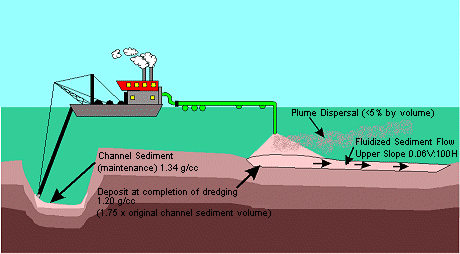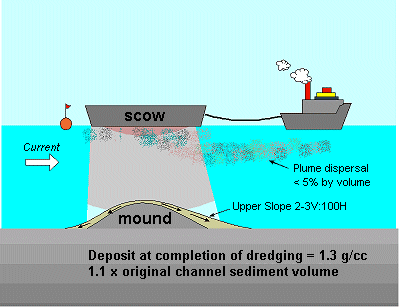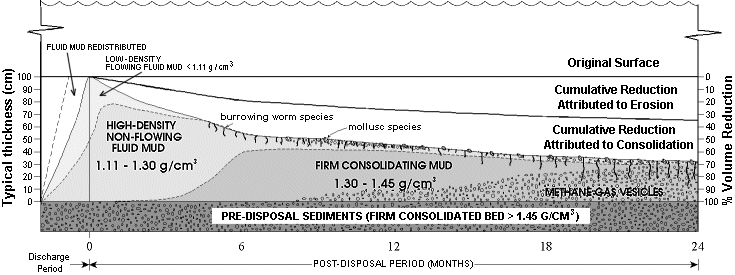Dredge Material Placement and Behavior
| Consolidation and Erosion Studies | contact: Stephen Van Ryswick ([email protected]) |
Regular and routine dredging of the shipping channels is required to enable vessels to access the Port of Baltimore. This process is termed maintenance dredging because it maintains the channels at the depth authorized. Prior to 2010 one option for disposing of the dredged sediments from channels outside of the Port was to place the material in open-water sites in the Chesapeake Bay. State law banned this method in 2010, and open water placement is no longer utilized. Prior to that time the Maryland Geological Survey conducted studies on the sediments placed in the open water sites.
Dredging Methods
Two different methods were generally used to dredge and transport sediments from channels to open-water sites: (1) hydraulic cutterhead suction dredge with transfer of the sediments via a connecting pipeline; and (2) clamshell bucket dredge with transfer of the sediments via towed bottom-release scows. Each produced a distinctly different deposit. Hydraulic dredging created a slurry of sediment and water which was pumped through a pipeline to a basin-like depression in proximity to the channel. The majority of the sediment settled to the bottom where it spread outward under the force of gravity and tended to fill the basin. This method of dredging and placement was last used in the northern Chesapeake Bay in 1997. The clamshell dredge scooped sediments relatively intact into waiting scows which were then towed to the designated area and released the sediment onto the bottom. This method usually produced positive relief features in the placement area. The clamshell bucket dredge method was used in the northern Chesapeake Bay prior to 1997 and up until 2010.
Specific Objectives of Studies
Annual monitoring: (1) to determine the placement location, thickness, and spatial extent of the deposited dredged sediment and evaluate changes in these characteristics through time; (2) to sample the deposited dredged sediments and determine their physical and bulk properties; (3) to conduct a volumetric evaluation of the deposits through time; and (4) to evaluate the consolidation and erosion of the deposited sediments after placement; (5) to recommend the most appropriate placement method and volume to management agencies to minimize the potential for adverse environmental impacts. Specialized studies: (1) to document the location and magnitude of elevated concentrations of suspended sediment in the water column resulting from disposal events and to determine the degree of transport under a variety of conditions; (2) to evaluate mass sediment movement from disposal sites; (3) to document changes in resuspension of deposited sediments over time under varying fair and storm weather conditions; (4) to explain the fate of the sediments from the time of discharge to deposition and subsequent burial by later deposits; and, (5) to determine the long-term capacity of the open-water placement sites given various disposal options.
Results of Studies
Questions have arisen over the "fate" of dredged sediments once placed in these sites. For those charged with maintaining channel depths, placement areas need to be chosen such that the dredged sediments do not move back into the channels, thereby presenting a navigation hazard and producing additional annual dredging requirements. Determining the amount of sediment that remains in place in the disposal areas facilitates planning for future site development. Resource managers concerned with minimizing repetitive impacts to the environment seek to reduce the annual dredging and to select placement areas and operations that insure adequate aquatic habitat, of good quality, for the future. The needs of both those charged with planning for and maintaining navigational access and those overseeing the management of aquatic resources can be met only with an adequate understanding of the fate of sediments deposited in the open-water sites.
A major component of the Program's effort is to effectively communicate the results of the studies to environmental and port administration managers. A number of reports have been produced which detail the results of specific studies and projects. Conceptual diagrams summarize the anticipated result of placing dredged sediment in the open-water sites.
 The following figure diagrams the hydraulic dredging and discharge operation and the characteristics of the deposited sediments. The dredging process increases the sediment water content and decreases the bulk density from an average of 1.34 g cm-3 found in the channel to 1.20 g cm-3 at the completion of disposal. During discharge the sediment/water slurry has a lower density and exhibits fluidized flow characteristics. Movement in excess of 1500 meters from the discharge point has been recorded in areas with sufficient bottom slope and morphologic characteristics. Placement sites for hydraulically dredged sediment have been selected to minimize the potential for fluidized flow of material back into the channels or into areas of prime aquatic habitat. At the completion of placement, the volume of the deposited sediment is approximately 1.7 times greater than the volume it occupied in the channel.
The following figure diagrams the hydraulic dredging and discharge operation and the characteristics of the deposited sediments. The dredging process increases the sediment water content and decreases the bulk density from an average of 1.34 g cm-3 found in the channel to 1.20 g cm-3 at the completion of disposal. During discharge the sediment/water slurry has a lower density and exhibits fluidized flow characteristics. Movement in excess of 1500 meters from the discharge point has been recorded in areas with sufficient bottom slope and morphologic characteristics. Placement sites for hydraulically dredged sediment have been selected to minimize the potential for fluidized flow of material back into the channels or into areas of prime aquatic habitat. At the completion of placement, the volume of the deposited sediment is approximately 1.7 times greater than the volume it occupied in the channel.
 The use of clamshell bucket dredging and transfer by bottom-release scow maintains much of the integrity of the sediments. The water content is increased only slightly, and the corresponding bulk density decreases from the average of 1.34 g cm-3 found in the channel to approximately 1.30 g cm-3 in the placement sites. The deposited sediment occupies a volume only about 1.1 times greater than it did in the channel, and the slope of the deposit is considerably greater than for hydraulically dredged and deposited sediments.
The use of clamshell bucket dredging and transfer by bottom-release scow maintains much of the integrity of the sediments. The water content is increased only slightly, and the corresponding bulk density decreases from the average of 1.34 g cm-3 found in the channel to approximately 1.30 g cm-3 in the placement sites. The deposited sediment occupies a volume only about 1.1 times greater than it did in the channel, and the slope of the deposit is considerably greater than for hydraulically dredged and deposited sediments.
Once placed on the bottom, the sediments undergo volumetric changes over time due to the expulsion of water and the erosion of sediment from the surface of the deposit. Thus, the deposit elevation decreases over time, while the bulk density increases due to the loss of water. Consolidation occurs at a relatively rapid rate during the first two months after placement and at a progressively more gradual rate thereafter. Within a few months of placement, opportunistic benthic invertebrate species native to the region begin to reinhabit the sediment. Soon thereafter, methane gas bubbles begin to appear in the deposit through the normal biogeochemical processes operating in this portion of the estuary.

Selected Publications
Capacity determinations for overboard disposal areas in the Pooles Island vicinity, J. Halka and W. Panageotou, Maryland
Geological Survey Open File Report No. 11, 1992.
Monitoring the overboard disposal of sediments dredged from the approach channel to the Chesapeake and Delaware Canal, October,
1990 - January, 1991, W. Panageotou and J. Halka, Maryland Geological Survey Open File Report No. 13, 1993.
Studies of dredged sediments placed in open-water sites in the northern Chesapeake Bay, October, 1991 - March, 1992, W.
Panageotou and J. Halka (eds.), Maryland Geological Survey File Report No. 94-1, 1994.
Resuspension studies conducted on dredged sediments placed in Area G-South, J. Halka, L. Sanford, and R. Ortt, Jr., Maryland
Geological Survey File Report No. 94-3, 1994.
Studies of sediments dredged from the approach channel to the Chesapeake and Delaware Canal, December, 1992 - January, 1993
and from the Baltimore Harbor Approach Channels, November, 1992 - March, 1993, W. Panageotou and J. Halka, Maryland Geological
Survey File Report No. 94-5, 1994.
Placement, consolidation, and erosion studies of sediments dredged from the approach channel to the Chesapeake and Delaware
Canal, October, 1997 - December, 1997, W. Panageotou, Maryland Geological Survey File Report No. 99-1, 1999.
Tidal resuspension of sediments in northern Chesapeake Bay, L. Sanford, W. Panageotou and J. Halka, 1991. Marine Geology,
volume 97, pp. 87-103.
Consolidation and erosion of deposited cohesive sediments in Northern Chesapeake Bay, USA, J. Halka, W. Panageotou and L.
Sanford. 1991, Geo-Marine Letters, volume 11, pp. 174-178.
Application of Studies on the Overboard Placement of Dredged Sediments to the Management of Disposal Sites, W. Panageotou
and J. Halka. 1994. in, McNair, E.C., Jr., ed., Dredging 94': Proceedings of the Second International Conference on Dredging
and Dredged Material Placement, Amer. Soc. Civil Engineers, N.Y., pp. 349-358.
Assessing the Fate of Dredged Sediments Placed in Open-Water Sites, Northern Chesapeake Bay J. Halka, W. Panageotou, W.
Sanford, and S-Y. Chao. 1994., in, McNair, EC, Jr., ed., Dredging 94': Proceedings of the Second International Conference
on Dredging and Dredged Material Placement, Amer. Soc. Civil Engineers, NY, pp. 1162-1171.
For More Information
Contact the Publications Office at (410) 554-5505 for a complete List of Publications.
Or contact: Stephen Van Ryswick ([email protected])) .


